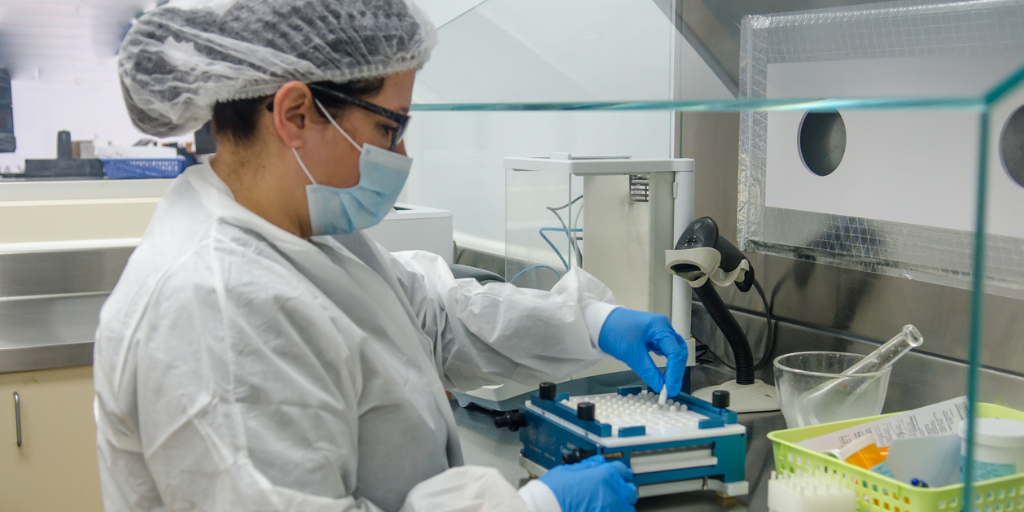Equipping a pharmacy laboratory isn’t about buying equipment - it’s about building a safe, compliant, and efficient environment. Whether you’re setting up a new lab or upgrading your existing space, understanding what equipment is essential - and how to choose the right options - can make a difference in both day-to-day operations and long-term success.
This guide will walk through the critical equipment every pharmacy cleanroom needs, highlight what to look for before making a purchase, and share practical insights into compliance, budgeting, and laboratory equipment distributor selection.
Checklist of Essential Equipment for Pharmacy Laboratories
All pharmacy laboratories, regardless of their specific focus, rely on a core set of equipment to ensure the safety and quality of their products. From initial preparation to the final compound, each piece of this core equipment plays an essential and unique role.
While the list below is not exhaustive, it identifies the basic equipment required for a safe, compliant, and efficient compounding pharmacy lab.
Essential Pharmacy Laboratory Equipment
Cleanroom Furnishings aren't about aesthetics they are about safety. Furnishing construction materials should be non-shedding, non-porous, and resistant to common cleaning agents. For this reason, stainless steel is a popular choice for its durability and ease of sanitation. The furnishings' design should be smooth and crevice-free to prevent the buildup of contaminants and allow for easy cleaning. Basic cleanroom furniture can include:
- Workstations and Tables
- Chairs and Stools
- Gowning Benches
- Garment Racks and Lockers
- Shelving and Cabinets
- Carts
- Sinks
Primary Engineering Controls (PECs) are the safety equipment that creates the controlled environment for compounding. Here are the most common of these critically important pieces of capital laboratory equipment:
Laminar Airflow Workstation (LAFW): Also known as a "clean bench," the LAFW protects the product from contamination by continuously washing the work area with HEPA-filtered air.
Key takeaway: Clean benches protect the product, not the user.
Biological Safety Cabinet (BSC): This is a more comprehensive solution. A BSC offers product, personnel, and environmental protection by using a combination of HEPA-filtered air and an air curtain at the cabinet opening.
Key takeaway: A BSC is essential for processing hazardous drugs (HDs).
Compounding Aseptic Isolator (CAI) / Compounding Aseptic Containment Isolator (CACI): These are fully enclosed glove boxes. A CAI is for non-hazardous compounding, while a CACI is for hazardous drugs. They offer a physical barrier between the operator and the product, providing a higher level of containment and control.
Balances and Scales: A pharmacy's reputation hinges on the accuracy of its preparations. You need both a high-capacity electronic balance for larger quantities and a more sensitive balance for milligram-level measurements. Consider:
- Analytical Balances
- Precision Balances
- Torsion Balances
Key features to look for: High sensitivity (e.g., ±1 mg), fast stabilization time, and a draft shield to protect from air currents. Regular calibration is mandatory for compliance and accuracy.
Mixers and Stirrers: These devices ensure that active ingredients are uniformly distributed throughout preparation. For example:
- Magnetic Stirrers
- Vortex Mixers
- Homogenizers
- Ointment Mills
- Blenders and Mortar and Pestle Systems
Evaluation tips: Look for variable speed control, consistent performance, and materials that are easy to clean and won't react with the compounded substances.
Cold Storage: Standard home refrigerators are not sufficient. You need a lab-grade refrigerator and freezer with precise temperature control and monitoring capabilities. Based on need consider:
- Pharmaceutical-Grade Refrigerators
- Under counter Refrigerators and Freezers
- General Purpose Refrigerators and Freezers
- Flammable Material Storage Refrigerators and Freezers
- Hazardous Drug (HD) Refrigerators
- Cryogenic Freezers
Key features: Digital temperature displays, alarms for out-of-range temperatures, and a validated temperature mapping study to ensure uniform temperature distribution.
Sterilizers: An autoclave is a must-have for sterilizing compounding tools and labware. To accommodate the variable equipment sterilization requirements, look to:
- Gravity Displacement Autoclaves (Class N)
- Pre-Vacuum Autoclaves (Class B)
- Steam-Pulsing Autoclaves (Class S)
Evaluation tips: Consider chamber size, cycle time, and the ability to validate sterilization cycles.
Analytical Instruments: For robust quality assurance, consider equipment like:
- pH Meters
- Spectrophotometers
- Dissolution Testers
- Refractometers
- Melting Point Apparatus
- Particle Size Analyzers
- Chromatography Systems
Compliance and Regulatory Considerations for Pharmacy Cleanroom Equipment
Beyond the essential equipment, a compounding laboratory's success and safety are inextricably entwined with adherence to regulatory standards. The tools you've just reviewed, while fundamental to the compounding process, must be properly maintained, calibrated, and comply with guidelines set by regulatory bodies, specifically the U.S. Pharmacopeia (USP). Commitment to compliance ensures not only the efficacy of the compounded products but also the safety of both the patients and the laboratory staff.
Laboratory equipment must align with the standards set by the USP. To get the ball of regulatory understanding rolling, here are some common standards relevant to compounding pharmacy laboratories:
USP <797> (Sterile Preparations): This chapter outlines the standards for compounding sterile products to prevent contamination.
Cleanroom design, including PECs, must meet ISO Class 5, 7, and 8 requirements for air changes per hour (ACPH), pressure differentials, and HEPA filtration.
USP <800> (Hazardous Drugs): This chapter focuses on the safe handling of hazardous drugs (HDs) to protect personnel and the environment.
If your lab works with HDs, a BSC or CACI is a non-negotiable engineering control. The equipment must be externally vented and placed in a negative-pressure room.
USP General Chapter <1229> Sterilization of Compendial Articles: This is the primary chapter that provides an overview of concepts and principles for sterilization, including moist heat sterilization (which is the method used by autoclaves). It covers topics like sterilization process development, validation, and ongoing assurance. It emphasizes the importance of a validated sterilization process and the use of biological indicators to confirm efficacy.
USP General Chapter <1079> Risks and Mitigation Strategies for the Storage and Transportation of Finished Drug Products: This is the most critical chapter. It presents a comprehensive framework for maintaining product quality during storage and distribution. For refrigerators and freezers, it outlines the importance of:
Temperature Ranges: It defines the acceptable temperature ranges for different storage conditions, such as:
- Freezer: -25°C to -10°C (-13°F to 14°F)
- Refrigerator: 2°C to 8°C (36°F to 46°F)
Qualification and Validation: All storage units must be qualified to prove they can consistently maintain the required temperature range under both empty and loaded conditions. This is often done through a process called temperature mapping, which identifies hot and cold spots within the unit.
Monitoring and Alarms: Refrigerators and freezers must have continuous temperature monitoring with a system that has an alarm to alert staff if the temperature goes outside the acceptable range. The monitoring devices themselves need to be regularly calibrated.
Emergency Plans: A written plan for handling temperature excursions, equipment failure, and power outages is required. This includes having a backup system or an alternative storage location.
USP General Chapter <800> Hazardous Drugs - Handling in Healthcare Settings: For hazardous drugs that require refrigeration, this chapter has additional requirements. It specifies that these drugs must be stored in a dedicated refrigerator that is placed in a negative-pressure area. Pass-through refrigerators are not allowed for these products. This is to protect healthcare workers from exposure.
Before purchasing laboratory equipment, ensure the equipment is certified to meet these and other standards. Always ask for documentation from a manufacturer.
Budgeting and Lifecycle Costs for Pharmacy Lab Equipment
Acquiring the proper compounding laboratory equipment is not merely a matter of following rules, it's also a strategic investment that can come with significant financial obligations. The initial acquisition cost, while a significant factor, is only one part of the total financial picture. True fiscal responsibility requires a forward-looking approach that considers the long-term expenses associated with maintaining a compliant pharmacy laboratory. It is important to have a comprehensive understanding of equipment life cycle costs, from validation and maintenance to eventual replacement. Consider:
- Initial Cost: The price of the equipment itself.
- Installation and Validation: Factor in the cost of professional installation and the required validation to ensure compliance.
- Operating Costs: Consider the ongoing costs of electricity, consumables (like filters and cleaning supplies), and routine calibration.
- Maintenance and Repair: Factor in the cost of preventative maintenance contracts and potential repairs.
- Decommissioning: Some equipment, especially for hazardous drugs, may require special a handling cost for disposal at the end of its life.
A life-cycle cost analysis helps identify the true cost of ownership of laboratory equipment over time.
Partner with CME Corp. for Pharmacy Laboratory Equipment
Equipping a pharmacy laboratory is a significant investment. By selecting high-quality, compliant equipment from a reputable vendor, you are not just buying equipment, you are building a foundation for safety, efficiency, and long-term success.
A reliable laboratory equipment distribution partner can offer focused expertise, acquisition support, delivery, installation, and biomedical equipment service to keep your operations running smoothly and compliantly.
CME Corp. is that distribution partner.
As experts in life science and healthcare equipment, and a contract holder with all major GPOs, CME provides more than just lab equipment. We offer end-to-end, value-added services. From CAD design and project management to warehousing, delivery, and ongoing technical support, CME helps ensure your facility is well-equipped—on time and on budget.
![]() Click CHAT to begin the conversation about your laboratory equipment needs.
Click CHAT to begin the conversation about your laboratory equipment needs.
About CME: CME Corp is the nation’s premier specialty distributor of healthcare and life sciences equipment. We partner with over 2,000 manufacturers to offer more than 2 million products across healthcare, laboratory, pharmacy, and research sectors. In addition to an extensive product portfolio, we also offer project management, CAD design, warehousing, logistics, consolidated direct-to-site delivery, and biomedical and technical services, all staffed by CME employees. Our mission, to help healthcare facilities nationwide reduce the cost of the equipment they purchase, make their equipment acquisition, delivery, installation, and maintenance processes more efficient, and help them seamlessly launch, renovate, or expand on schedule, is supported by 25 service locations strategically located across the country.



